Artful Breakdown: A Sweet Suite of Sagas
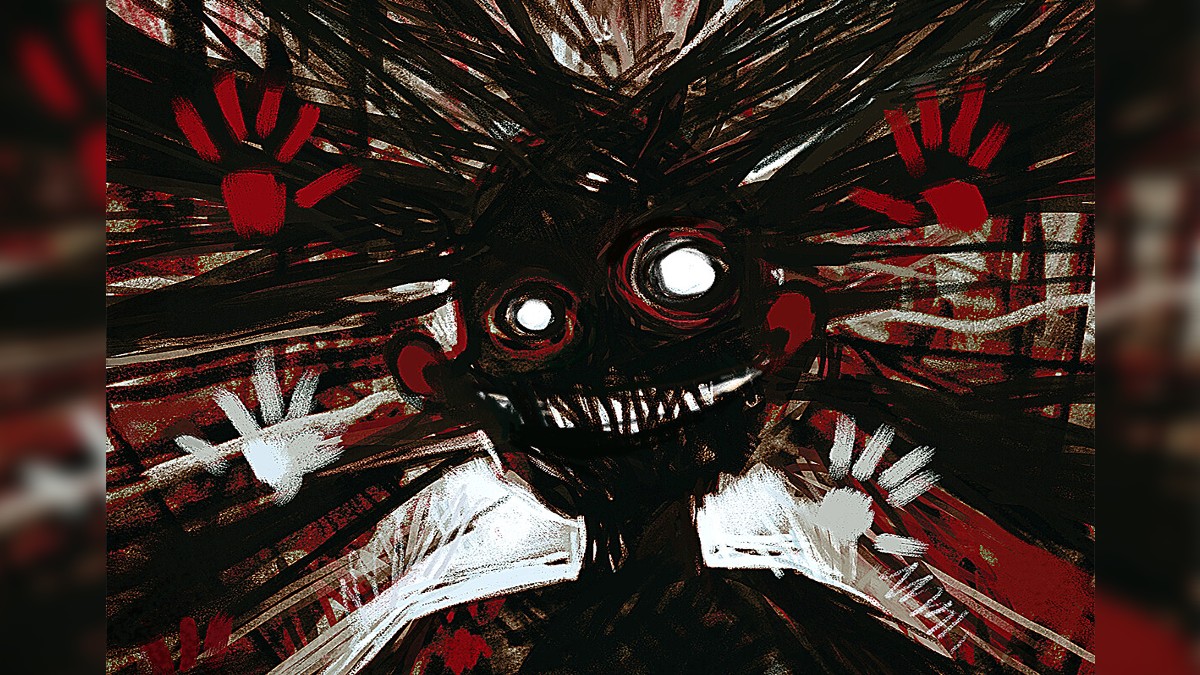
Braids's Frightful Return by Dominik Mayer
Hello folks, and welcome back to Artful Breakdown. As of writing this, Magic is returning to its home and dredging up the past with the return of the Phyrexians to once more threaten the plane in Dominaria United. It's a set rich with history, callbacks, and lore that has me absolutely giddy.
If this is your first time, welcome to Artful Breakdown. Here, we look at some of the fantastic art that comes out of Magic: the Gathering sets and dissect the tricks that make it work as well as appreciate some stuff you can't always see at card size.
And for a set so packed with history, what better card type to focus on than Sagas! We've got two cycles: one at uncommon and one at rare, and I'll be taking you on a tour through my favorites out of the bunch. Along the way we'll go over some of the challenges and opportunities Sagas provide the amazing illustrators who work on them.
The Saga of Sagas
Introduced the last time we were on Dominaria, Sagas depict art from the plane and tell a story from that world. A Dominaria Saga feels different from one on Theros and both feel different from Kaldheim. Even their frame is different, with its own requirements of the artist. The portrait orientation immediately changes the available space and readability from the already cramped real estate of a Magic card.
But these constraints have led to artists coming up with masterful methods to manage them. I hope you're ready for some fantasy art history. Let's go!
The Love Song of Night and Day by Eli Minaya
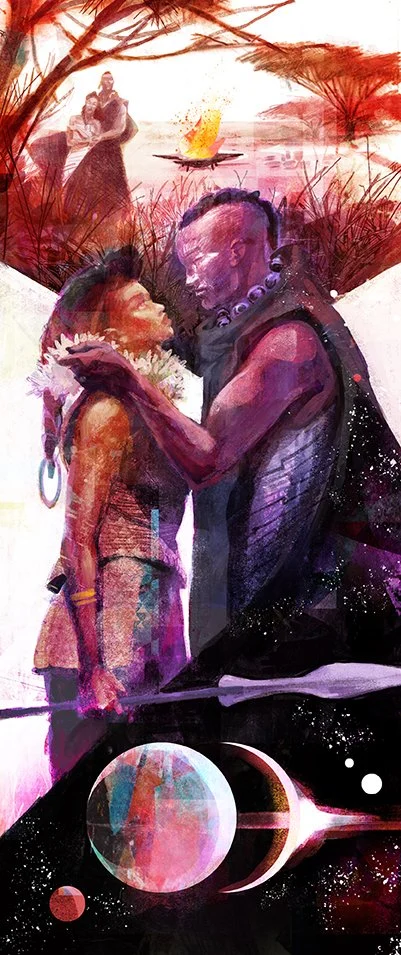
New to the game, Eli Minaya only has two pieces on cards so far. Both are in this set and both are ephemeral and gorgeous. I first found his work through some of his collage pieces, and he brings that look into what he's done here. It looks like very little like anything else in the game, and I can't wait to see more of it. That ephemeral quality lends itself perfectly to a Saga adapting a poem in the game called The Love Song of Night and Day that stretches across a plethora of cards.
The Saga evokes the feeling of memory centering our figures in the middle frame but, since we read top to bottom, we begin with what is implied to be the memory of the characters meeting and sharing time together. The washed-out, near monochrome colors makes clear that this is history and a memory they share, mirroring the way a sepia filter signals a flashback in a film.
The piece captures the feeling of brief but glorious moments of connection in between the moments life pulls us apart, which is the underlying theme of the poem and uses geometry and shape language fantastically. The sweep and color of Night's cape even lead us to the last frame that hammers home the metaphor and beauty of the poem, when Night and Day meet in an eclipse. It's a perfect capstone to punctuate the poignant elements of the story.
The Phasing of Zhalfir by LA Draws
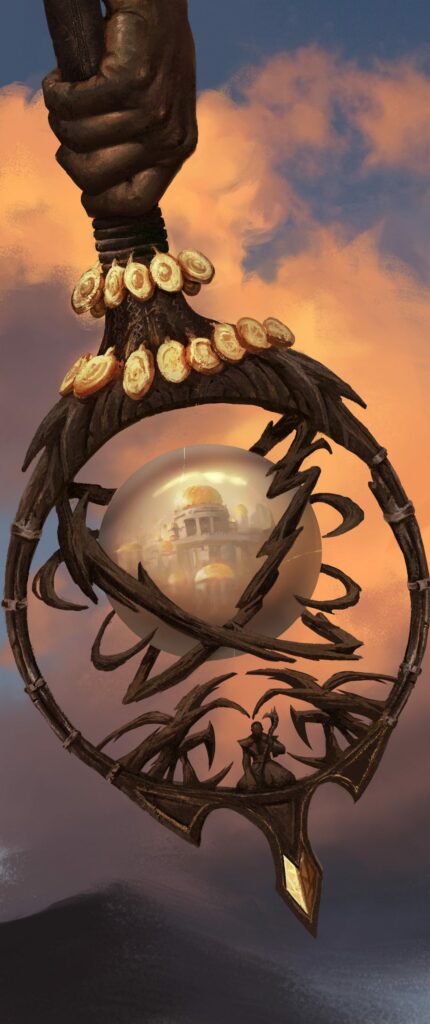
Another new face to the artist roster, LA Draws is a Nigerian artist whose previous work can be seen in the recent Blood Artist reprint. Their storytelling skills are strong, and while I don't think the Blood Artist made great use of their abilities, this just hits different!
On their Twitter, they talk about doing something like what some other artists, including one further down on this list, did and making a physical piece of media, like a mural or carving. In the end I'm glad they didn't for this one because instead we get a focus on a staff carried by Teferi himself.
Starting high, we see a hand tightly gripping the staff, holding it close. Reflected in the sphere, we see the towering halls of a set of buildings: Zhalfir. Long ago, Teferi phased it out of time to protect his home from the Phyrexian invasion, but there was one problem: he never figured out how to undo it. There's an immense amount of story here, but to make it short, that mistake has been with Teferi ever since.
In fact, if you zoom in you can even see a stylized Teferi bowing his head in shame and frustration at the bottom. The image pulls double duty, telling us not just about Teferi's action, but his grief. The man's conscience is so burdened, he literally carries a reminder of it with him.
Braids's Frightful Return by Dominik Mayer
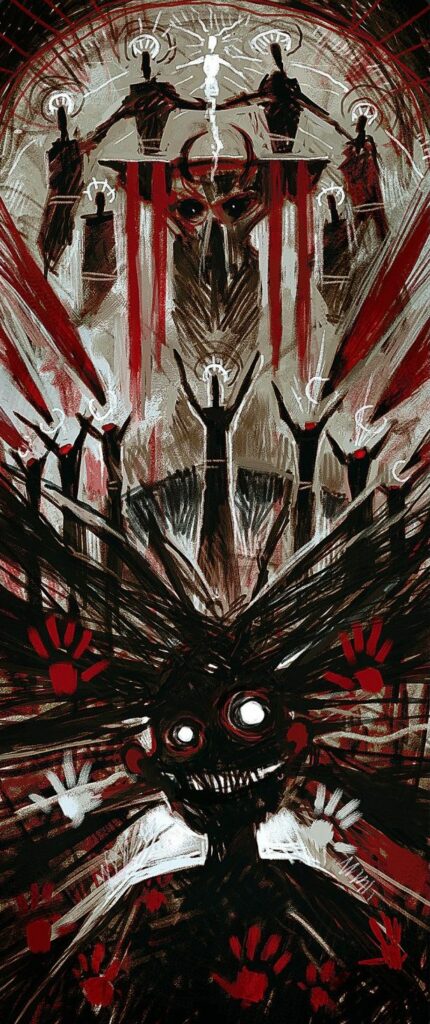
Right now, Mayer's got about 45 cards to his name, starting with the Strixhaven Mystical Archives, and every one is certified gold. He's a master of easy-to-read abstraction, and again, his stylization looks like nothing else in the game right now. Braids's Frightful Return is no different.
It uses the vertical format to slowly move us through a terrifying story with a piece designed to look like a child's crayon drawing from a horror film marrying purpose and style to depict the gruesome ritual that gives us this set's new Braids retrain. Using only black, white, red, and brown, Mayer creates a scene of abject horror worthy of Braids's new nightmarish form.
The scratchy, scribbly line work and frantic energy in Braids's wild hair make the whole thing haunting in the way only a good black card can be. The stark red fountains of blood and the simple shapes force us to fill in the blanks in our own minds as to what this may have looked like in action.
It even leads us to ask, "Who did this almost cave art style recreation of the ritual?" Was it a surviving cabal member... or is the large cackling grin that takes up the bottom third of the frame a self-portrait from the nightmarish Braids herself.
The Elder Dragon War by Filip Burburan
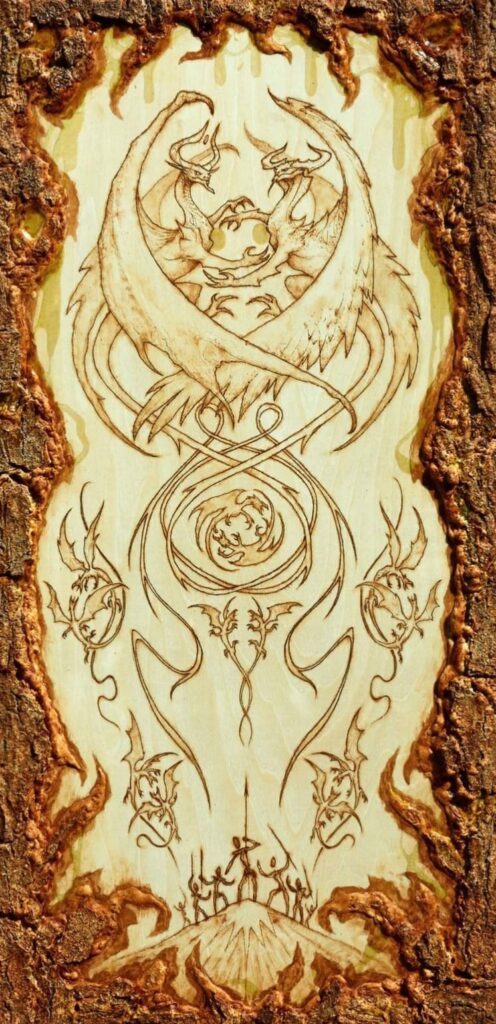
This is the physical piece out of the five I mentioned, and it exemplifies some of the opportunities that Sagas give artists to stretch beyond their comfort zone. Filip's been painting for the game for a while; his first pieces go back to M15. Usually his style is identifiable by saturated colors and a focus on creatures and monsters. It's clear that his love is for the beasts and creatures of the multiverse. Or at least, that's the work WotC tends to send his way, and he's quite good at it.
Most of his pieces are the kind of bread and butter work that doesn't get appreciated enough in a set, but he's a natural fit for The Elder Dragon War, and he hit it out of the park!
A stark departure from his usual style, this wood burning even uses a bark frame and careful stylization to realize a clear idea of Ugin and Nicol Bolas locked in combat. You can still see the rigorous attention to the form of the draconic figures that keeps them recognizable. The dragons' spiraling tails move us through several stylized images of dragons fighting each other, even getting down to the small, nearly stick figure humans looking on in awe.
This pulls off two tricks at once. The first, due to the level of detail and rendering, our eye goes straight to the dragons and wants to keep coming back to them. They're the focal point and most interesting part of the story. The second is that it hammers home the kind of in-world storytelling. The piece feels like an ancient relic made by people who witnessed an event and were naturally way more interested in the giant nearly godlike monsters battling than rendering humans accurately.
The Weatherseed Treaty by Livia Prima
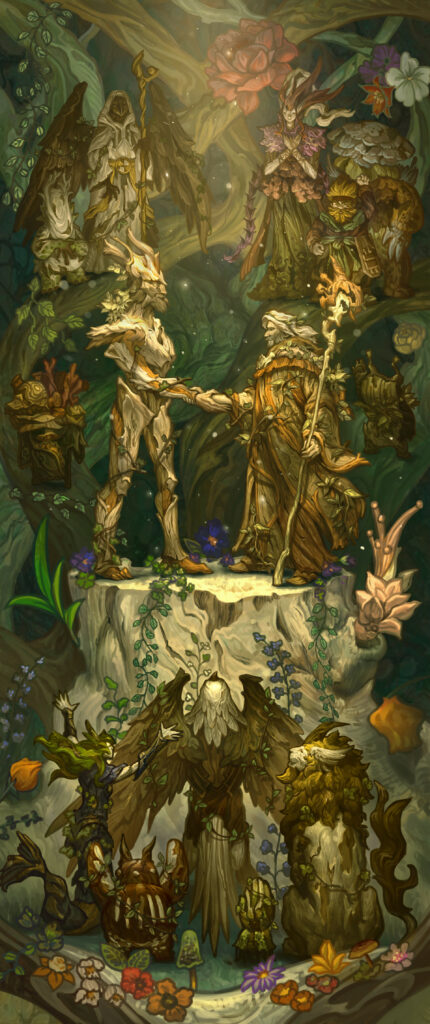
Livia Prima is just a master of light and color who I'm ashamed I didn't know about before researching this. That said, I'd seen a few pieces from her before now, including things from her artist series where she does excellent character work. The Weatherseed Treaty, however, also feels like a bit of a break from the norm for her, feeling like a strange combination of an illuminated manuscript and a statue created by druidic magic.
I could see this in a children's book or as a depiction of a statue in an elven glen. Yet even as the image steps away from some of the elements of her old work, you can still see a character-driven focus and a deft handling of light and shadow. Gentle dappled light illuminates the scene, actually encouraging us to read in ascending order rather than descending.
Bright areas at the tops of surfaces give the whole image a hopeful feeling, and the masterful use of various greens to make the piece interesting is highly evident. That's how good Prima's control of color and value is. You can see similar deftness in her Jenson Carthalion and Glissa Sunseeker arts, but this piece takes it to another level.
The Final Chapter
And now we reach our tale's end. We've seen masters shake things up and new storytellers make their first marks on the multiverse. I hope you've enjoyed these as much as I did. The artists working on this are amazing and at the top of their game. It gets even more amazing to think about when you realize that, with the two-year timeframe that Wizards uses, these pieces were made in 2020 during the height of COVID lockdowns. If there's one thing I hope people take away from these, it's just how much work goes into making the art for this game we all love.
Until next time when the Saga continues, take care. Leave a comment below about your favorite Sagas or read more of my work here.